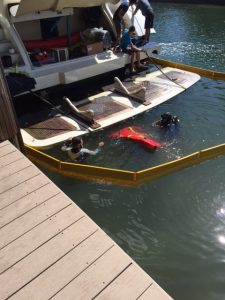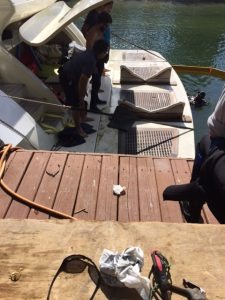
Platform submerged
Our hydraulics team at High Seas Hydraulics was recently called out to help the captain of a 95 foot Technema yacht docked behind a private residence with a problem with the ship’s hydraulic swim platform. The hydraulic swim platform was stuck in the down position below the water line and leaking hydraulic fluids into the water. Before the team started to work on raising and securing the hydraulic swim platform, they needed to contain the leaking hydraulic fluids. Upon arriving on site, they quickly deployed a special containment boom and secured it to the transom of the boat. They also used absorbent pads to filter the hydraulic fluids that had already leaked into the water. Once the boom was secured, the work could commence to start to raise the hydraulic swim platform so that the yacht could be moved to a yard for repair.
For this job, we hired professional divers to deploy air bags under the platform to raise it enough to use a pulley and ratchet system to hoist the hydraulic swim platform back onto the the locking hooks on the transom of the boat where it would normally rest. We first needed to

Divers with air bags
secure the hydraulic swim platform with straps that we could attach to the ratchet system in order to help raise it after the air bags
were inflated.
Once the hydraulic swim platform was raised a couple of inches with the air bags, we disconnected the hydraulic hoses on the inboard side of the unit to alleviate back pressure to help stem the flow of any additional hydraulic fluid into the water. Relieving the back pressure also allowed the hydraulic cylinders to move more freely in order to raise the hydraulic swim platform. After the hydraulic swim platform was aligned and snug to the boat, it was further secured with straps and the locking hooks for its journey to the boat yard.

Platform secured to transom
One of the primary reasons for a failure of this type is wear and tear and prolonged exposure to sea water of the hydraulic cylinders and hoses that are located on the outboard side of the yacht. To avoid this type of problem, it is a good idea to inspect the hydraulic cylinders and hoses every time the boat is hauled and refurbish or replace them at the first sign of wear on the components. Spending a little time and money to keep the parts of the hydraulic swim platform that are exposed to sea water in top operating condition can ultimately save you big money in the future, not to mention potential fines and citations should your vessel leak hydraulic fluids into the waterways. While this type of failure is not prevalent, the day after we performed this job we were called out to perform the exact same thing on a 64 foot Azimut.




